Synergistic Effect of Nano-Silica and Intumescent Flame Retardant on the Fire Reaction Properties of Polypropylene Composites
Abstract
1. Introduction
2. Materials and Methods
2.1. Materials
2.2. Synthesis of Silica Nanoparticles
2.3. Preparation of Intumescent Flame Retardant Polypropylene Composites
2.4. Characterization
3. Results and Discussion
3.1. Effect of Nano-Silica on the LOI Values and UL-94 Ratings of Polypropylene Composites
3.2. Morphologies of Nano-Silica and Its Dispersion in Polypropylene Composites
3.3. Heat Release Properties of Polypropylene Composites
3.4. Smoke Property
3.5. Flame Retardancy Performance
3.6. Analysis of Charred Residue
4. Conclusions
Author Contributions
Funding
Institutional Review Board Statement
Informed Consent Statement
Data Availability Statement
Conflicts of Interest
References
- Pérez, N.; Qi, X.-L.; Nie, S.B.; Acuña, P.; Chen, M.-J.; Wang, D.-Y. Flame retardant polypropylene composites with low densities. Materials 2019, 12, 152–162. [Google Scholar] [CrossRef] [PubMed]
- Eagan, J.M.; Xu, J.; Di Girolamo, R.; Thurber, C.M.; Macosko, C.W.; LaPointe, A.M.; Bates, F.S.; Coates, G.W. Combining polyethylene and polypropylene: Enhanced performance with PE/iPP multiblock polymers. Science 2017, 355, 814–816. [Google Scholar] [CrossRef] [PubMed]
- Ameli, A.; Nofar, M.; Park, C.; Pötschke, P.; Rizvi, G. Polypropylene/carbon nanotube nano/microcellular structures with high dielectric permittivity, low dielectric loss, and low percolation threshold. Carbon 2014, 71, 206–217. [Google Scholar] [CrossRef]
- Várdai, R.; Lummerstorfer, T.; Pretschuh, C.; Jerabek, M.; Gahleitner, M.; Bartos, A.; Móczó, J.; Anggono, J.; Pukánszky, B. Improvement of the impact resistance of natural fiber-reinforced polypropylene composites through hybridization. Polym. Adv. Technol. 2021, 32, 2499–2507. [Google Scholar] [CrossRef]
- Tang, W.; Wang, H.; Yang, Q.; Liu, F.; Dessie, W.; Luo, X.; Peng, C.; Zhang, S.; Shi, K.; Sun, W.; et al. An efficient and eco-friendly route to prepare graphene nanosheet and its effect on the flammability of polypropylene composites. Polym. Adv. Technol. 2021, 32, 3358–3361. [Google Scholar] [CrossRef]
- Wang, D.; Echols, K.; Wilkie, C.A. Cone calorimetric and thermogravimetric analysis evaluation of halogen-containing polymer nanocomposites. Fire Mater. 2005, 29, 283–294. [Google Scholar] [CrossRef]
- Thanh, T.T.N.; Decsov, K.E.; Bocz, K.; Marosi, G.; Szolnoki, B. Development of intumescent flame retardant for polypropylene:Bio-epoxy resin microencapsulated ammonium-polyphosphate. Period. Polytech. Chem. Eng. 2022, 66, 313–324. [Google Scholar] [CrossRef]
- Ali, I.; Jim, N.K.; Bhattacharyya, D. Effects of graphene nanoplatelets on mechanical and fire performance of flax polypropylene composites with intumescent flame retardant. Molecules 2021, 26, 4094. [Google Scholar] [CrossRef]
- Bourbigot, S.; Sarazin, J.; Bensabath, T. Intumescent polypropylene in extreme fire conditions. Fire Saf. J. 2020, 120, 103082. [Google Scholar] [CrossRef]
- Martins, R.C.; Rezende, M.J.C.; Nascimento, M.A.C.; Nascimento, R.S.V.; Ribeiro, S.P.d.S. Synergistic action of montmorillonite with an intumescent formulation: The impact of the nature and the strength of acidic sites on the flame-retardant properties of polypropylene composites. Polymers 2020, 12, 2781. [Google Scholar] [CrossRef]
- Demirhan, Y.; Yurtseven, R.; Usta, N. The effect of boric acid on flame retardancy of intumescent flame retardant polypropylene composites including nanoclay. J. Thermoplast. Compos. Mater. 2022, 36, 1187–1214. [Google Scholar] [CrossRef]
- Sun, Y.; Yuan, B.; Shang, S.; Zhang, H.; Shi, Y.; Yu, B.; Qi, C.; Dong, H.; Chen, X.; Yang, X. Surface modification of ammonium polyphosphate by supramolecular assembly for enhancing fire safety properties of polypropylene. Compos. Part B Eng. 2020, 181, 107588. [Google Scholar] [CrossRef]
- Dong, F.Q.; Luo, Z.L.; Wang, B.B. Preparation of Mn2+ doped piperazine phosphate as a char-forming agent for improving the fire safety of polypropylene/ammonium polyphosphate composites. Materials 2021, 14, 7589. [Google Scholar] [CrossRef]
- Xu, B.; Shao, L.; Wang, J.; Liu, Y.; Qian, L. Enhancement of the intumescent flame retardant efficiency in polypropylene by synergistic charring effect of a hypophosphite/cyclotetrasiloxane bi-group compound. Polym. Degrad. Stab. 2022, 181, 109281. [Google Scholar] [CrossRef]
- Wu, Z.; Wang, Q.; Fan, Q.; Cai, Y.; Zhao, Y. Synergistic effect of Nano-ZnO and intumescent flame retardant on flame retardancy of polypropylene/ethylene-propylene-diene monomer composites using elongational flow field. Polym. Compos. 2019, 40, 2819–2833. [Google Scholar] [CrossRef]
- Liu, W.; Nie, L.; Luo, L.; Yue, J.; Gan, L.; Lu, J.; Huang, J.; Liu, C. Enhanced dispersibility and uniform distribution of iron phosphonate to intensify its synergistic effect on polypropylene-based intumescent flame-retardant system. J. Appl. Polym. Sci. 2020, 137, 49552. [Google Scholar] [CrossRef]
- Khanal, S.; Lu, Y.; Dang, L.; Xu, S. Improving the flame retardancy of intumescent flame retardant/high-density polyethylene composites using surfactant-modified montmorillonite clay. J. Appl. Polym. Sci. 2022, 139, e51940. [Google Scholar] [CrossRef]
- Khanal, S.; Lu, Y.; Ahmed, S.; Ali, M.; Xu, S. Synergistic effect of zeolite 4A on thermal, mechanical and flame retardant properties of intumescent flame retardant HDPE composites. Polym. Test. 2020, 81, 106177. [Google Scholar] [CrossRef]
- Zhang, L.; Chen, S.; Pan, Y.-T.; Zhang, S.; Nie, S.; Wei, P.; Zhang, X.; Wang, R.; Wang, D.-Y. Nickel metal-organic framework derived hierarchically mesoporous nickel phosphate toward smoke suppression and mechanical enhancement of intumescent flame retardant wood fiber/poly(lactic acid) composites. ACS Sustain. Chem. Eng. 2019, 7, 9272–9280. [Google Scholar] [CrossRef]
- Yuan, B.; Fan, A.; Yang, M.; Chen, X.; Hu, Y.; Bao, C.; Jiang, S.; Niu, Y.; Zhang, Y.; He, S.; et al. The effects of graphene on the flammability and fire behavior of intumescent flame retardant polypropylene composites at different flame scenarios. Polym. Degrad. Stab. 2017, 143, 42–56. [Google Scholar] [CrossRef]
- Bifulco, A.; Tescione, F.; Capasso, A.; Mazzei, P.; Piccolo, A.; Durante, M.; Lavorgna, M.; Malucelli, G.; Branda, F. Effects of post cure treatment in the glass transformation range on the structure and fire behavior of in situ generated silica/epoxy hybrids. J. Sol-Gel Sci. Technol. 2018, 87, 156–159. [Google Scholar] [CrossRef]
- Wu, Z.-H.; Guo, J.-X.; Fan, Q.-X.; Wang, Q.; Cai, Y.-J.; Zhao, Y.-Q. A comparison of thermal degradation kinetic mechanisms between elongational and shearing flow fields for nano-silica/IFR synergistic fire retardant polypropylene nanocomposites. Mater. Express 2019, 9, 1033–1042. [Google Scholar] [CrossRef]
- Dogan, M.; Bayramli, E. Synergistic effect of boron containing substances on flame retardancy and thermal stability of clay containing intumescent polypropylene nanoclay composites. Polym. Adv. Technol. 2011, 22, 1628–1632. [Google Scholar] [CrossRef]
- Ye, L.; Wu, Q.; Qu, B. Synergistic effects of fumed silica on intumescent flame-retardant polypropylene. J. Appl. Polym. Sci. 2010, 115, 3508–3515. [Google Scholar] [CrossRef]
- Pedrazzoli, D.; Pegoretti, A.; Kalaitzidou, K. Interfacial interactions in silica-reinforced polypropylene nanocomposites and their impact on the mechanical properties. Polym. Compos. 2016, 37, 2018–2026. [Google Scholar] [CrossRef]
- Lu, F.; Wu, S.-H.; Hung, Y.; Mou, C.-Y. Size effect on cell uptake in well-suspended, uniform mesoporous silica nanoparticles. Small 2010, 5, 1408–1413. [Google Scholar] [CrossRef]
- ASTM D2863-97; Standard Test Method for Measuring the Minimum Oxygen Concentration to Support Candle-Like Combustion of Plastics (Oxygen Index). ASTM: West Conshohocken, PA, USA, 1997.
- ASTM D3801; Standard Test Method for Measuring the Comparative Burning Characteristics of Solid Plastics in a Vertical Position. ASTM: West Conshohocken, PA, USA, 2020.
- ISO 5660-1:2015; Reaction-to-Fire Tests—Heat Release, Smoke Production and Mass Loss Rate—Part 1: Heat Release Rate (Cone Calorimeter Method) and Smoke Production Rate (Dynamic Measurement). ISO: Geneva, Switzerland, 2015.
- Wang, Y.; Meng, X.; Wang, C.; Han, Z.; Shi, H. Fire reaction properties of polystyrene-based composites using hollow silica as synergistic agent. J. Therm. Anal. Calorim. 2021, 146, 1679–1686. [Google Scholar] [CrossRef]

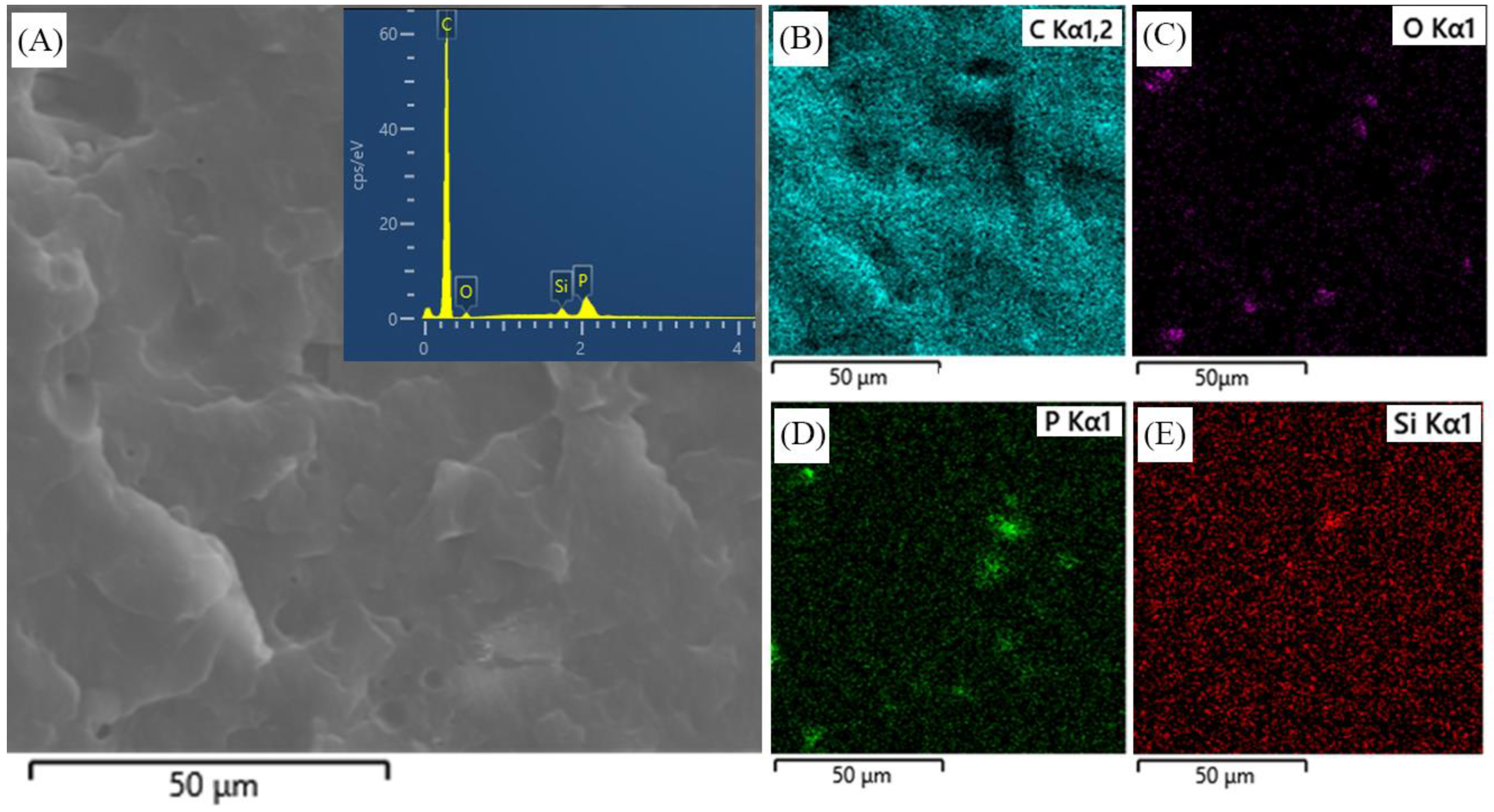
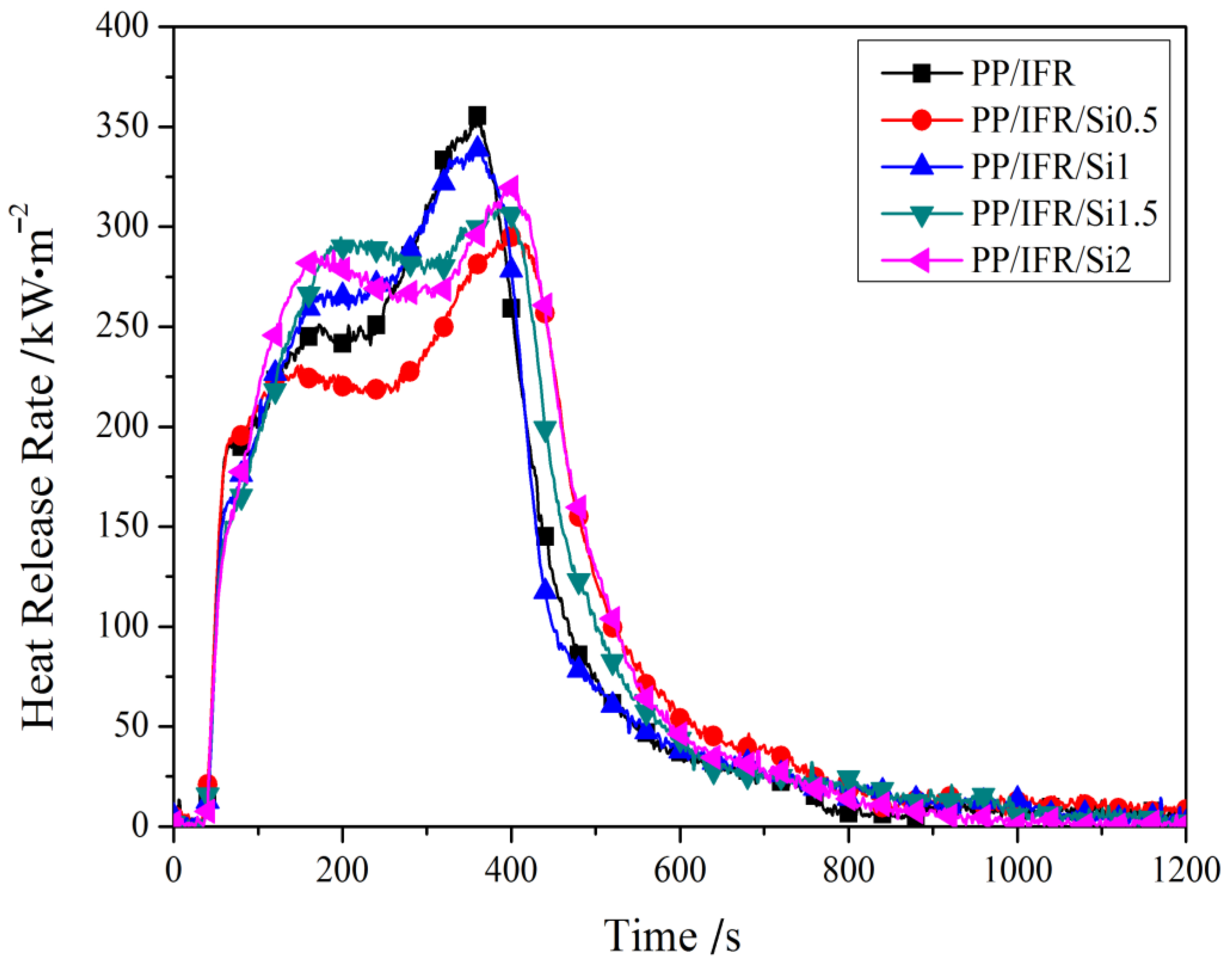
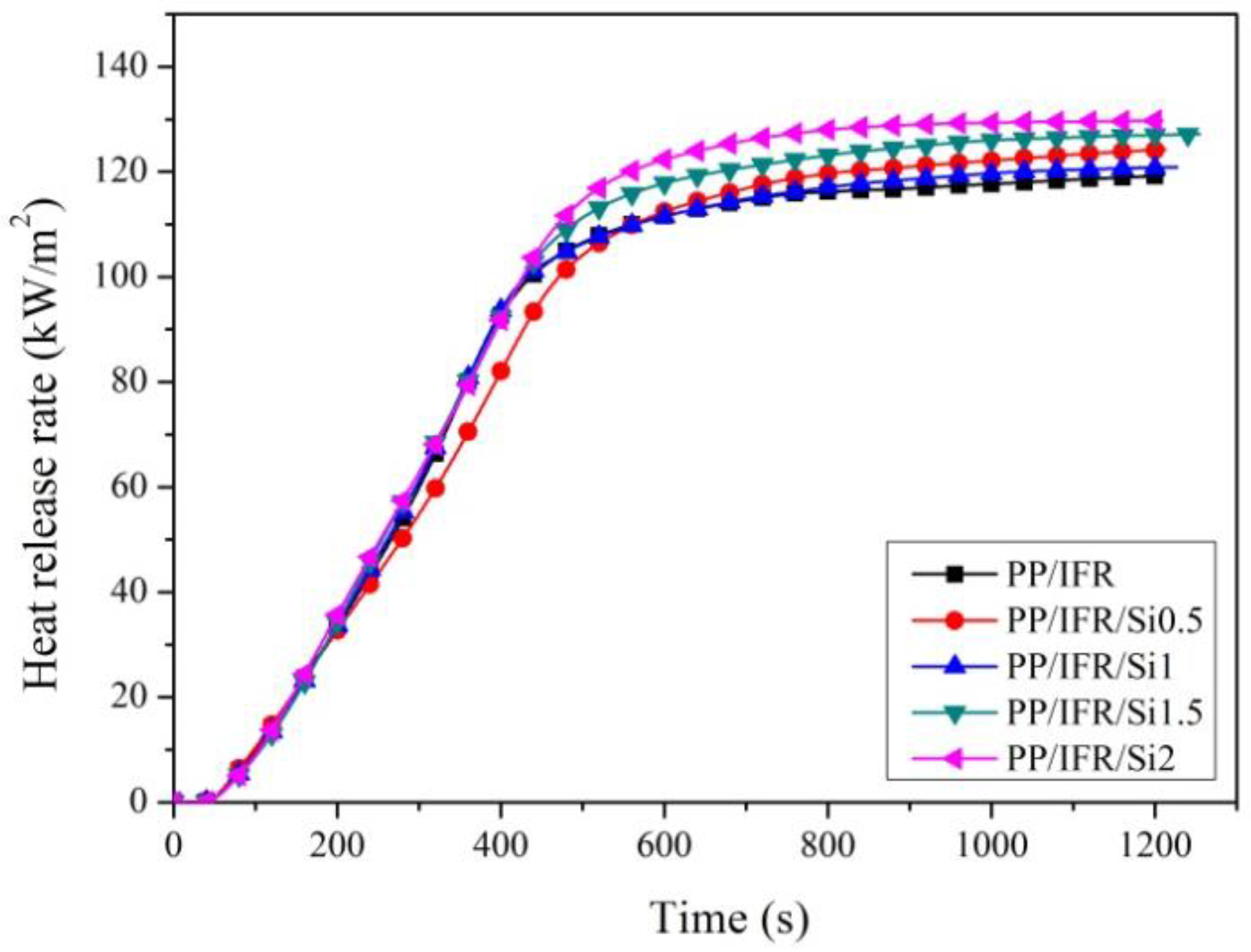
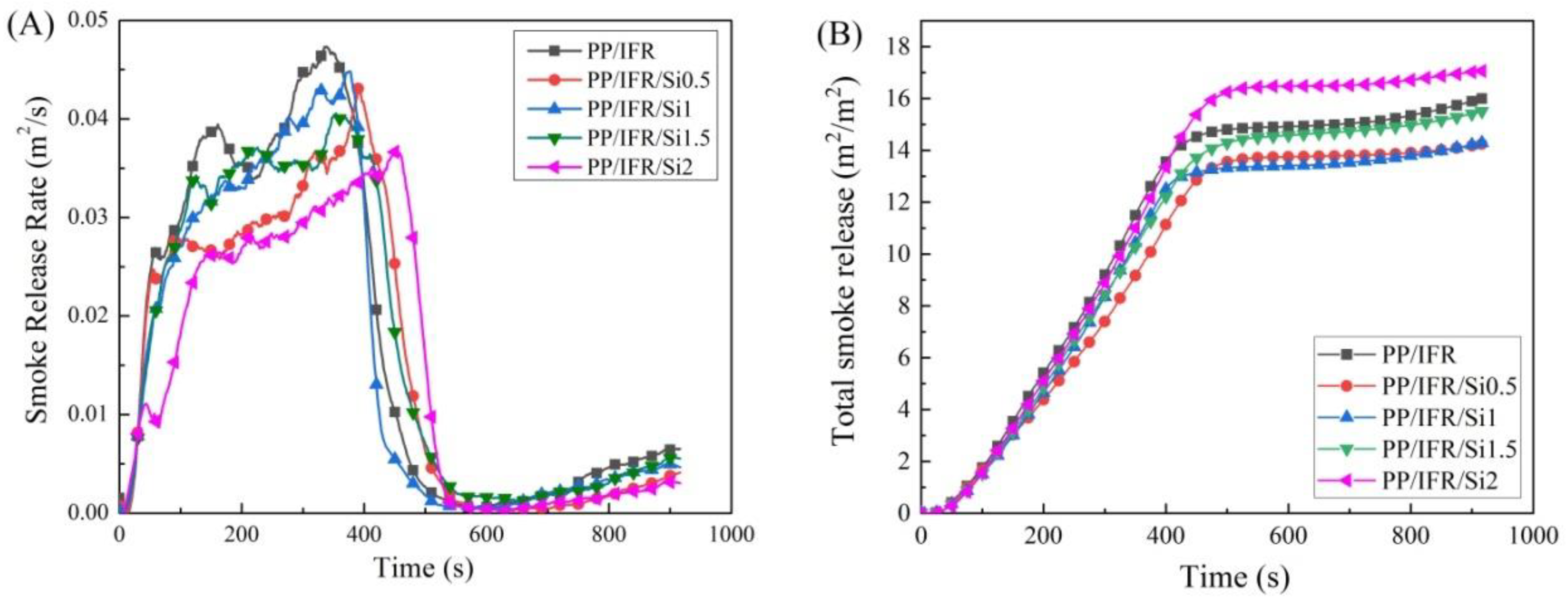
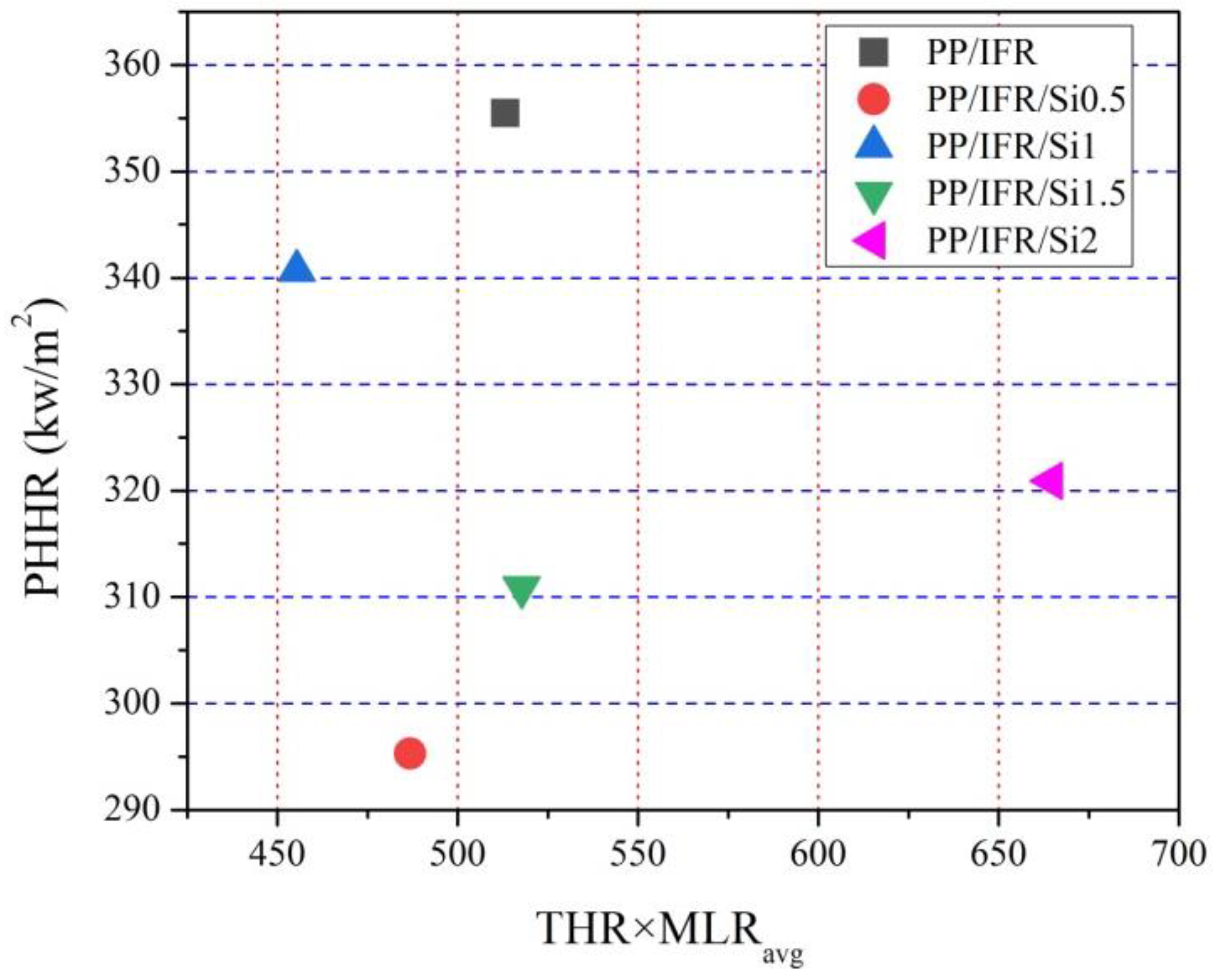
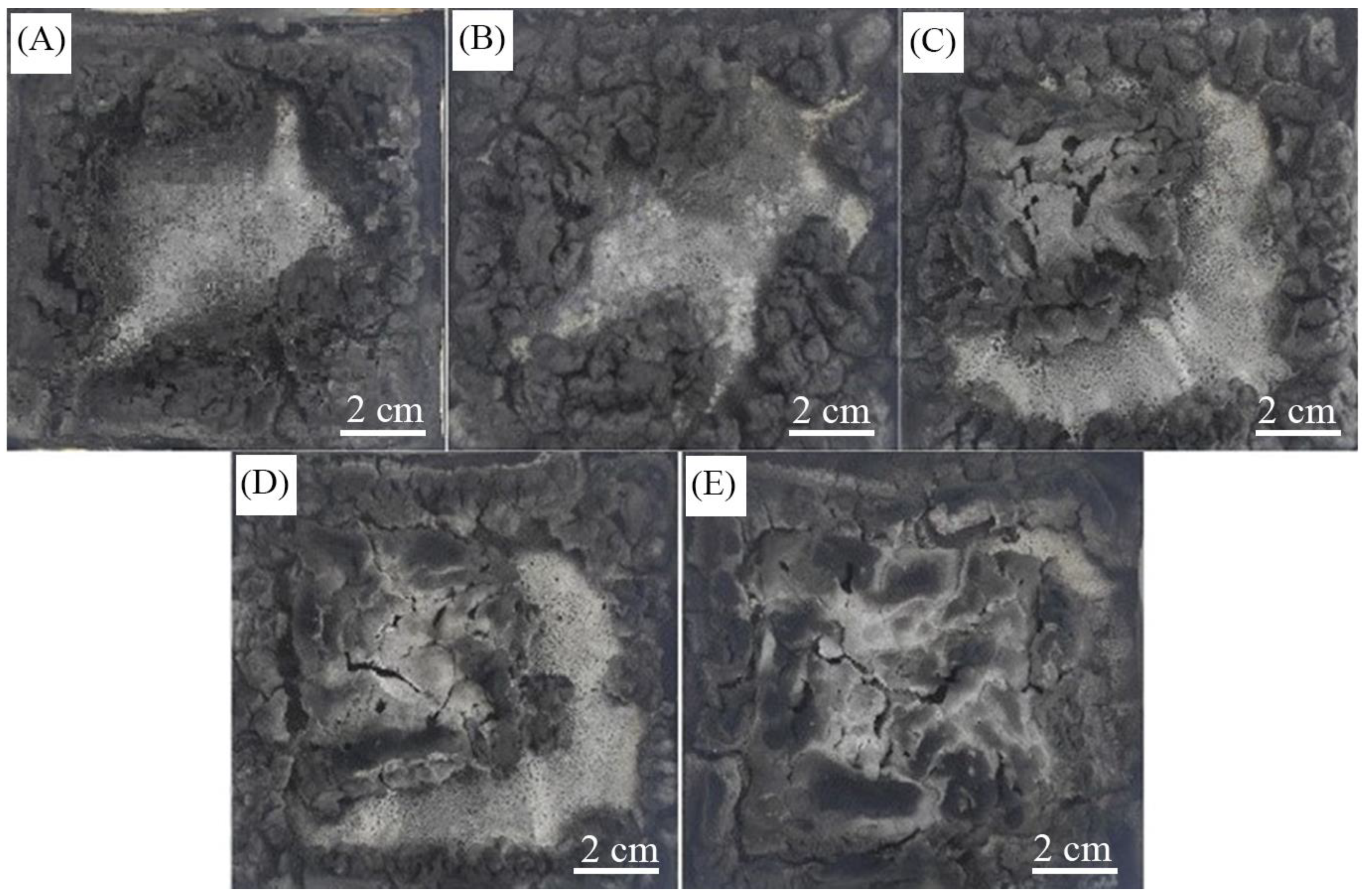

| Samples | Description | PP (wt.%) | APP (wt.%) | PER (wt.%) | Nano-Silica (wt.%) | Stearic Acid (wt.%) | Antioxidants (wt.%) |
|---|---|---|---|---|---|---|---|
| PP | PP | 99 | 0 | 0 | 0 | 0.5 | 0.5 |
| PP/IFR | PP/IFR | 70 | 19.35 | 9.65 | 0 | 0.5 | 0.5 |
| PP/IFR/Si0.5 | PP/IFR with 0.5 wt.% nano-silica | 70 | 19 | 9.5 | 0.5 | 0.5 | 0.5 |
| PP/IFR/Si1 | PP/IFR with 1.0 wt.% nano-silica | 70 | 18.6 | 9.4 | 1.0 | 0.5 | 0.5 |
| PP/IFR/Si1.5 | PP/IFR with 1.5 wt.% nano-silica | 70 | 18.33 | 9.17 | 1.5 | 0.5 | 0.5 |
| PP/IFR/Si2 | PP/IFR with 2.0 wt.% nano-silica | 70 | 18 | 9 | 2.0 | 0.5 | 0.5 |
| Samples | UL-94 Rating | LOI (%) |
|---|---|---|
| PP | NR | 17.5 |
| PP/IFR | NR | 25.4 |
| PP/IFR/Si0.5 | V-2 | 26.7 |
| PP/IFR/Si1 | V-1 | 27.3 |
| PP/IFR/Si1.5 | NR | 27.6 |
| PP/IFR/Si2 | NR | 26.4 |
| Samples | Tensile Strength (MPa) | Elongation at Break (%) |
|---|---|---|
| PP/IFR | 16.35 ± 0.24 | 45 ± 4 |
| PP/IFR/Si0.5 | 17.07 ± 0.29 | 47 ± 4 |
| PP/IFR/Si1 | 17.31 ± 0.34 | 48 ± 4 |
| PP/IFR/Si1.5 | 18.03 ± 0.34 | 48 ± 5 |
| PP/IFR/Si2 | 18.99 ± 0.41 | 50 ± 5 |
| Sample | TTI (s) | PHRR (kW·m−2) | Time to PHRR (s) | THR (MJ·m−2) | MLRavg (g·s−1·m−2) | SEA (m2·kg−1) | TSR (m2·m−2) |
|---|---|---|---|---|---|---|---|
| PS/IFR | 32 | 355.5 | 360 | 126.1 | 4.07 | 507.8 | 1689.1 |
| PS/IFR/Si0.5 | 30 | 295.3 | 396 | 124.2 | 3.92 | 421.2 | 1509.6 |
| PS/IFR/Si1 | 31 | 340.7 | 362 | 120.8 | 3.77 | 392.5 | 1508.8 |
| PS/IFR/Si1.5 | 30 | 310.9 | 395 | 127.2 | 4.07 | 441.1 | 1637.4 |
| PS/IFR/Si2.0 | 31 | 320.9 | 398 | 129.8 | 5.12 | 518.1 | 1802.5 |
| Location of Char Residue | C (wt.%) | O (wt.%) | P (wt.%) | Si (wt.%) |
|---|---|---|---|---|
| Surface | 18.76 | 55.34 | 17.87 | 8.02 |
| Middle | 26.85 | 51.84 | 17.24 | 4.07 |
| Bottom | 31.51 | 52.09 | 16.33 | 0.06 |
Disclaimer/Publisher’s Note: The statements, opinions and data contained in all publications are solely those of the individual author(s) and contributor(s) and not of MDPI and/or the editor(s). MDPI and/or the editor(s) disclaim responsibility for any injury to people or property resulting from any ideas, methods, instructions or products referred to in the content. |
© 2023 by the authors. Licensee MDPI, Basel, Switzerland. This article is an open access article distributed under the terms and conditions of the Creative Commons Attribution (CC BY) license (https://creativecommons.org/licenses/by/4.0/).
Share and Cite
Wang, Y.; Liu, B.; Chen, R.; Wang, Y.; Han, Z.; Wang, C.; Weng, L. Synergistic Effect of Nano-Silica and Intumescent Flame Retardant on the Fire Reaction Properties of Polypropylene Composites. Materials 2023, 16, 4759. https://doi.org/10.3390/ma16134759
Wang Y, Liu B, Chen R, Wang Y, Han Z, Wang C, Weng L. Synergistic Effect of Nano-Silica and Intumescent Flame Retardant on the Fire Reaction Properties of Polypropylene Composites. Materials. 2023; 16(13):4759. https://doi.org/10.3390/ma16134759
Chicago/Turabian StyleWang, Yongliang, Baoqiang Liu, Ruiyang Chen, Yunfei Wang, Zhidong Han, Chunfeng Wang, and Ling Weng. 2023. "Synergistic Effect of Nano-Silica and Intumescent Flame Retardant on the Fire Reaction Properties of Polypropylene Composites" Materials 16, no. 13: 4759. https://doi.org/10.3390/ma16134759
APA StyleWang, Y., Liu, B., Chen, R., Wang, Y., Han, Z., Wang, C., & Weng, L. (2023). Synergistic Effect of Nano-Silica and Intumescent Flame Retardant on the Fire Reaction Properties of Polypropylene Composites. Materials, 16(13), 4759. https://doi.org/10.3390/ma16134759






